Many people have heard about Peruvian guinea pigs but very few know details about them. When you are thinking of having a new pet in your family, you better be prepared for its needs. You need to know what are his living habits, what food you should buy for him etc. In this article, we will teach you all about the Peruvian guinea pig so that you can be fully prepared of buying or adopting one.
General Info About The Peruvian Guinea Pig
Being one of the most beautiful breeds of guinea pigs, the Peruvian is quite rare to find. Native from Peru, Argentina and Bolivia, they are a classified kind of breed and a non-self variety of guinea pigs. They are born with short hair, but it grows long and until they reach maturity, their hair can measure up to 50 cm. The hair will part naturally down their spine and will show its coat in the most beautiful way. Because of the long hair, they will need great maintenance which implies washing and grooming them more often than other breeds of guinea pigs. The colors of the Peruvian can be extremely varied. For example, they can be bi-color or even tricolor.
Peruvian’s coat can have many colors and patterns. You can also find them single colored, also called as “self” Peruvians. Two colored Peruvian is pretty common but tri-colored is the rarest. Tri-colored Peruvian pig is perfect for people who plan to have a show guinea pig.
The most common colors you can find in Peruvians is light brown, dark brown, white and black. Moreover, there are also gray colored Peruvians but these guinea pigs are not as common.
They are often mistaken with another breed of guinea pigs, more exactly the Abyssinian guinea pig, because they look the same when they haven’t reached their maturity. They can live from 5 to 6 years and the females can start breeding at the age of 20 weeks up to 1 year. On average, the number of litters is 3 but they can reach up to 6 or even more.
They are recommended to people who are older because they need extra care and it would be difficult for a child to take care of a Peruvian guinea pig. They will need to be washed and groomed periodically because their coat needs to always be clean and sleek. Daily brush is mandatory in order to maintain a glowing look of the coat. Even if they need more attention from you, they deserve it. They are very playful, fun and charismatic.
Peruvian Guinea Pig’s Personality
The Peruvian is a little curious guinea pig. These little critters are alert and like to explore their surroundings. A Peruvian cavvy is a loving critter and enjoys the attention and company of their human parents.
It’s best to have some extra time to interact and play with this breed of guinea pigs. When Peruvians gets comfortable with you, they will love you and make all kinds of guinea pig sounds.
These cavies are social breeds and it is recommended to give them a cage mate. However, you need to make sure that the cage is big enough to prevent dominance and fights.
How To Brush And Groom a Peruvian Guinea Pig
In order to not fill its cage or box with hair, its coat should be brushed daily or at least once a week. Also, this way you can remove large particles of dust and prevent his fur from becoming matted. Now this is something that most guinea pigs don’t like, especially when they are brushed over the lower back area. You need to brush really gently. It’s better to do it with a wide toothed comb or a softish baby brush. You should never pull a guinea pig’s fur, specifically on the rear end where they are very sensitive.
A guinea pig with severely tangled hair should be bathed first. This way it is easier to untangle the hair carefully using the fingers, baby shampoo and conditioner. After your pet is gently dried, you can comb the guinea pig. For any extra tangles, you should hold the hair with your fingers and comb the ends first, carefully working your way towards the skin. However, bathing can also be quite stressful for guinea pigs, and is not recommended. Most guinea pigs don’t even need it, unless they have lice, are extra smelly, dirty or have severely tangled fur.
A grooming routine should be started when your cavy is still very young so they get used to the experience and learn to enjoy it. Once a week, you should groom its coat with scissors and a fine comb. Pay attention when you cut your pet’s coat, he may get hurt easily. A great piece of advice is to keep it distracted in order to finish your job without any accidents. The best way to distract a guinea pig is with the help of some fresh food. Make sure that the length of the hair will permit it to move without any difficulties.
Diet
The diet of a Peruvian is not very different form the diet of any guinea pig. They will love a good dry mix of guinea pig food which offer proteins, fibers and minerals. Because guinea pigs don’t have vitamin C in their little bodies, it is necessary to give them fresh food which contains this vitamin. You can give them fruits or vegetables but not in large amounts.
Now comes the question: “What kind of fruits and vegetables should I give my pet?” No worries, we have all the answer. Fruits like strawberries, apples, melon, blueberries and bananas can be excellent treats for your little buddy. Also, the vegetables that will give it the essential vitamin C are: carrots, romaine lettuce, spinach, broccoli, tomato, parsley, dandelion, Chinese cabbage and clover. When you want to introduce new fresh food in his diet, make sure that he likes it first.
Make sure that the water is changed daily because it can get easily contaminated and your little friend can get sick.
For living environment, you should buy a medium cage with plastic base where you can put wood shavings. They will need a tube or a box in their cage in order to exercise and play. They must exercise daily to avoid weight problems.
Where To Buy A Peruvian Guinea Pig
It’s not easy to find a Peruvian guinea pig. They are not as common and you most likely won’t find them in local pet shops. Occasionally you may be able to find them at the rescues though. One of the rescues you can check out is https://www.petfinder.com/. You can also search for a reputable breeder in your area and you may want to check out some guinea pig sale/adoption directories as well.
When looking to adopt a Peruvian guinea pig, make sure it is a healthy animal. A healthy cavvy will have good teeth, brilliant eyes, and nice healthy coat. Any sex or age will make a good pet. However, since Peruvians are very social critters, you should plan on getting more than one. Just make sure they have enough room in their cage and get a same sex or you could end up having babies.
The average cost of Peruvian guinea pigs range anywhere from 30-60 dollars.
Conclusion
So, as you can see, the Peruvian is a beautiful creature that needs a little more attention than other breeds of guinea pigs. However, Peruvian guinea pigs are not ideal for small children. If you have young kids, American guinea pig would be more suitable for them. This cavvy is generally raised by adults or guinea pig enthusiasts who can dedicate enough time for them. This is the main reason they are not as popular as some of the other types of guinea pigs.
If you plan to show off a guinea pig in competition, this is a fantastic breed to look into. Just make sure you can allocate enough time to do so.
Related Articles:
References:
http://www.onlineguineapigcare.com/peruvian-guinea-pig/
http://animal-world.com/encyclo/critters/guin_pig/PeruvianGuineaPig.php
http://www.petplanet.co.uk/small_breed_profile.asp?sbid=21
http://www.pets4homes.co.uk/pet-advice/a-short-guide-to-the-peruvian-guinea-pig.html
http://exoticpets.about.com/od/guineapigs/a/gpgrooming_2.htm

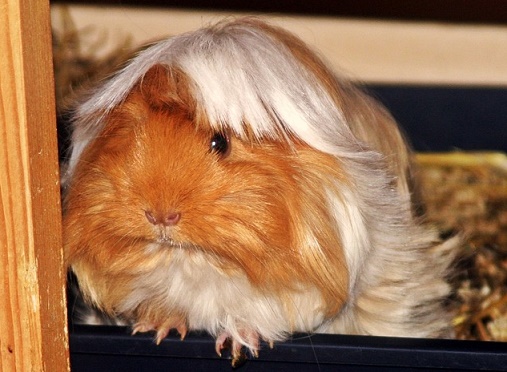
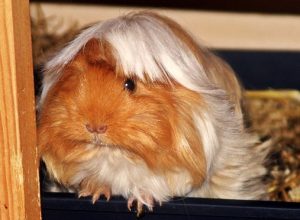

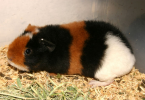

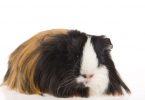
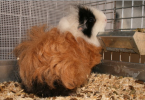
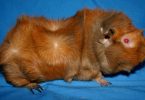
Hi there,
I was astonished to find 2 of my guinea pigs on your website, the Peruvian (it’s Sunshine) and the Rex (it’s Josie).
Please, NEVER BRUSH YOUR PERUVIAN! It’s much too stressful for the piggy and it isn’t necessary at all. I never brush Sunshine, but keep her Kennel very clean and cut her hair regularly, so she can walk around without stepping on her fur and without peeing on it. Also, the forehead hair should be cut so that she can see and eat without hair in her eyes or mouth.
I’d be glad, if you’d change your tip about brushing.
Thanks in advance
Irini
Hi Irini,
Thanks for stopping by. Yes, these lovely pictures were taken form a website that provides “free for commercial use” photos. Your guinea pigs are gorgeous! I always strive to provide accurate information on my website. Reading from numerous sources, they recommended brushing and combing a Peruvian guinea pig. However, you are right most guinea pigs don’t like brushing. Many have recommended a fine toothed steel comb or a brush that’s meant for infants.
Thanks for your advice though! If you have any more tips, please let me and my readers know.
Hello. I have a question. My guinea pig is a bit agressive, when I try to play with him he bytes me. What can be the reason of such behaviour ?
There can be many reasons for such behavior:
* They might be unhappy with their cage. For example, the cage might be too small and they get bored and grumpy.
* Generally cavies don’t like to be carried or held in a wrong way.
* If you hold them and they need to do their “business”. Guinea pigs like to urinate in private.
* They might have skin parasites or mites which make their skin sensitive to a touch.
* If they are petted in the opposite direction of their fur.
* They might be sensitive to certain areas such as their rumps.
* They have been held for a while and they simply want to go back to their cage.
* They need to get used to their new owner. This make take weeks or months.
* When they progress to adulthood (4-12 months). Once they reach maturity, the biting stops.
* If they are scared. For example, loud noise or unfamiliar surroundings.
* In rare cases, the guinea pigs may just have an attitude.
I thought I should chime in to say that guinea pigs require more than a medium sized cage purchased at a pet store. To date, the only cage I know of geared towards a single guinea pig that is the proper size is the Midwest Guinea Habitat Plus, at 8 square feet. At minimum, a single guinea pig requires 7.5 square feet and since they are social animals, it’s best to have at least two of the same sex (unless one has been neutered/spayed), where you may also get away with a 7.5 square foot cage but it’s generally recommended you go bigger (10.5 square foot is the preferred size I believe). The most common way (though certainly not the only way) of getting a properly sized cage/enclosure is to make a C&C cage (cubes and coroplast cage).
Food-wise, I think it should be mentioned that grass hay should be available to the guinea pig(s) 24/7 (grass hay=timothy, orchard, meadow, etc.) and should make up the majority (80-85 percent I think) of their diet. Fruits are fine as an occasional treat or in small amounts a couple of times a week but the bulk of their fresh food should be leafy greens (green/red leaf lettuce or any other lettuce other than iceberg tend to be a staple as a daily veggie here) and to be careful with certain vegetables (cabbage broccoli and other veggies in their family) as they may cause bloat in some pigs. Bell peppers are also a great source of vitamin C (any color though red has the highest amount). As adults, I believe the general “rule” so to speak, is about a cup of veggies a day/(adult) pig and 1/8 cup pellets (free feeding pellets is not recommended). Hay and veggies (but especially hay) are the most important parts of a guinea pig’s diet.
I recommend checking out sites such as guineapigcages.com or guinealynx (which is very well-respected in the cavy community and has a wealth of information, particularly concerning possible health/medical issues)